Strategic Management and Sustainability: AstraZeneca Case Study Report
VerifiedAdded on 2022/12/14
|10
|3121
|284
Report
AI Summary
This report provides a comprehensive strategic analysis of AstraZeneca, a leading multinational pharmaceutical and biotechnology company. It begins with an introduction to strategic management and its importance in achieving organizational goals. The main task involves assessing the UK and global pharmaceutical industries, considering the impact of the COVID-19 pandemic, and utilizing frameworks like PESTEL and Porter's Five Forces to analyze the competitive environment. The report examines the industry's growth, challenges, and opportunities, including the increasing demand for pharmaceuticals and the influence of political, economic, social, technological, environmental, and legal factors. Furthermore, it analyzes AstraZeneca's competitive position, employing Porter's Five Forces, strategic group analysis, and industry life cycle models. The analysis considers the company's strengths, weaknesses, and strategic responses to maintain its competitive advantage. The report concludes with a summary of the key findings and strategic recommendations for AstraZeneca, emphasizing the need for continuous adaptation and innovation in the face of evolving market dynamics.
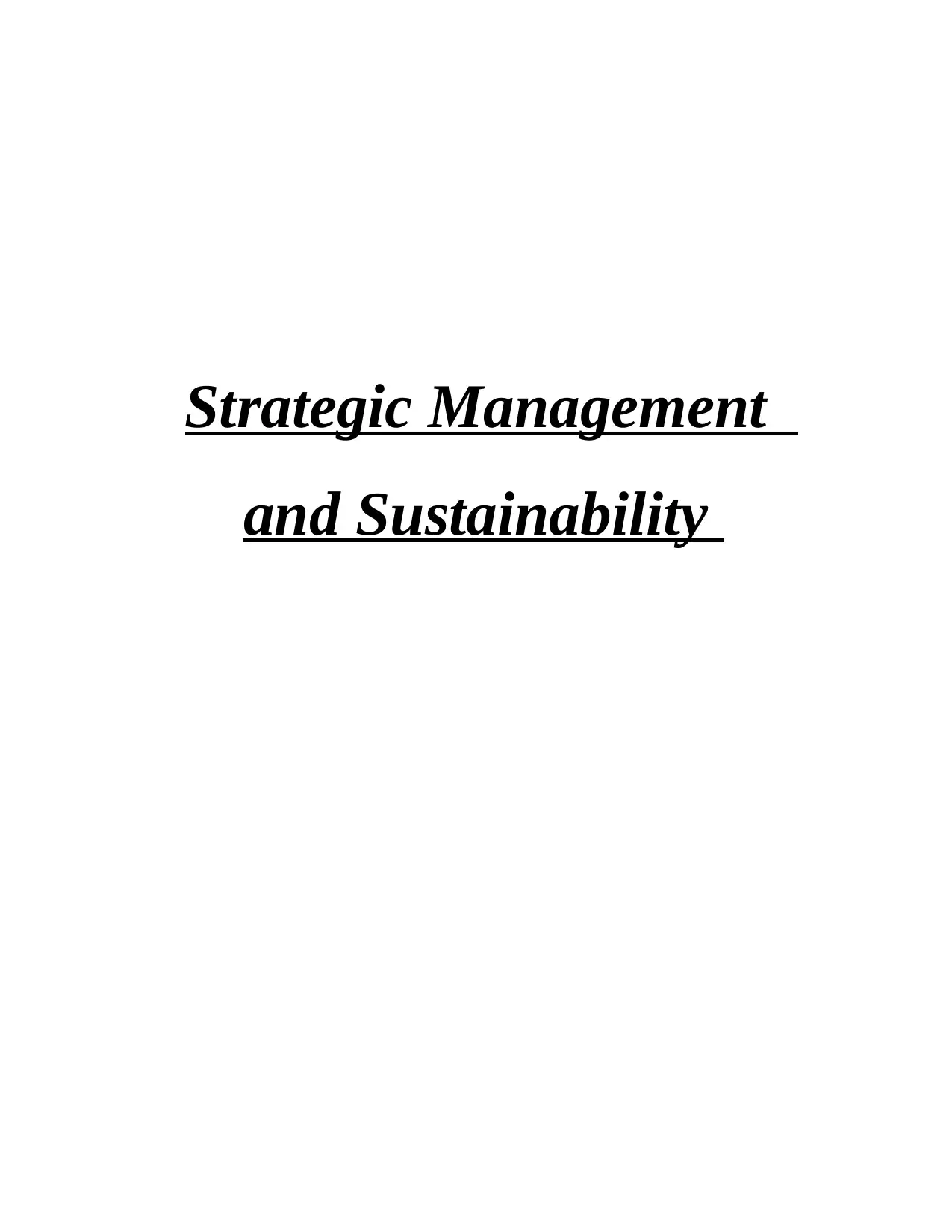
Strategic Management
and Sustainability
and Sustainability
Paraphrase This Document
Need a fresh take? Get an instant paraphrase of this document with our AI Paraphraser
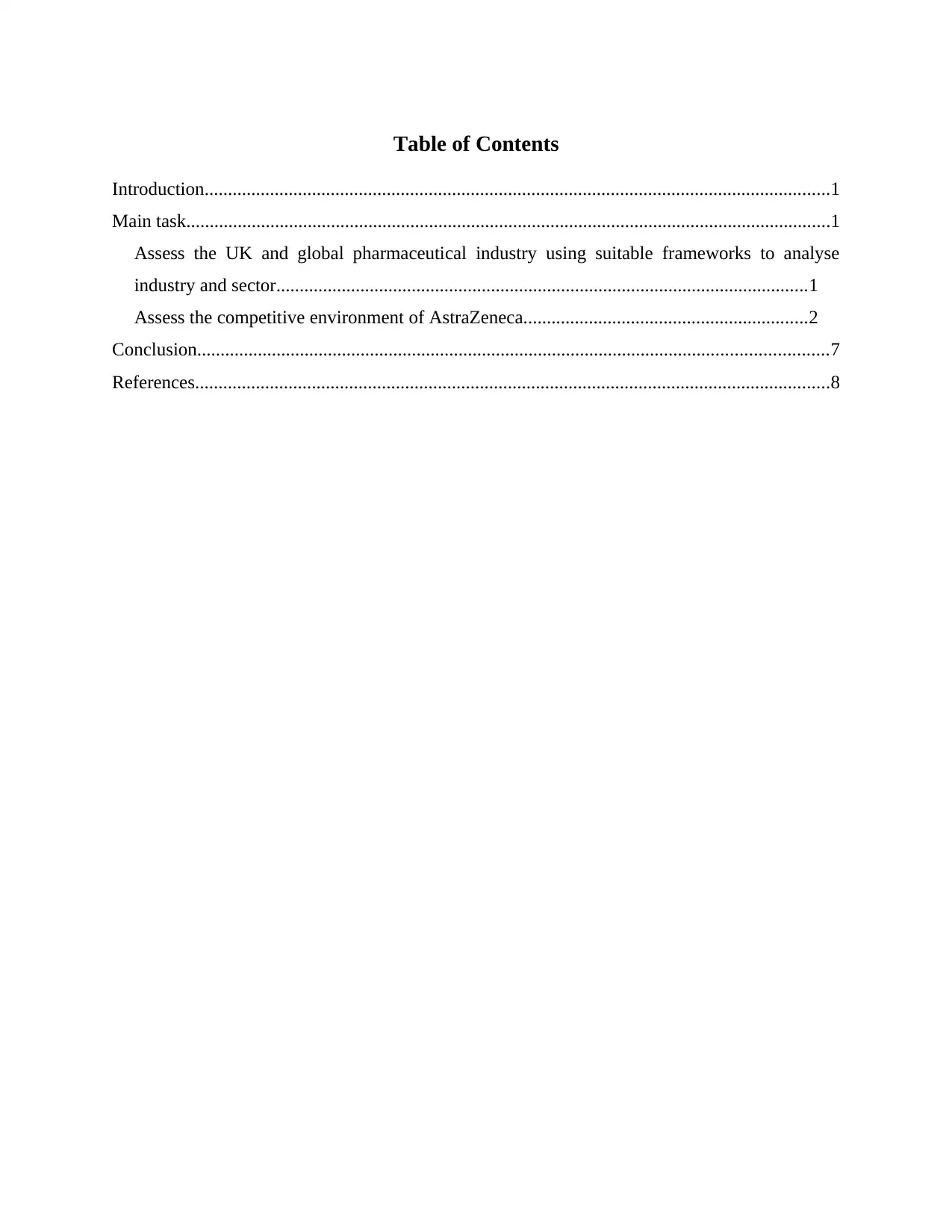
Table of Contents
Introduction......................................................................................................................................1
Main task..........................................................................................................................................1
Assess the UK and global pharmaceutical industry using suitable frameworks to analyse
industry and sector..................................................................................................................1
Assess the competitive environment of AstraZeneca.............................................................2
Conclusion.......................................................................................................................................7
References........................................................................................................................................8
Introduction......................................................................................................................................1
Main task..........................................................................................................................................1
Assess the UK and global pharmaceutical industry using suitable frameworks to analyse
industry and sector..................................................................................................................1
Assess the competitive environment of AstraZeneca.............................................................2
Conclusion.......................................................................................................................................7
References........................................................................................................................................8
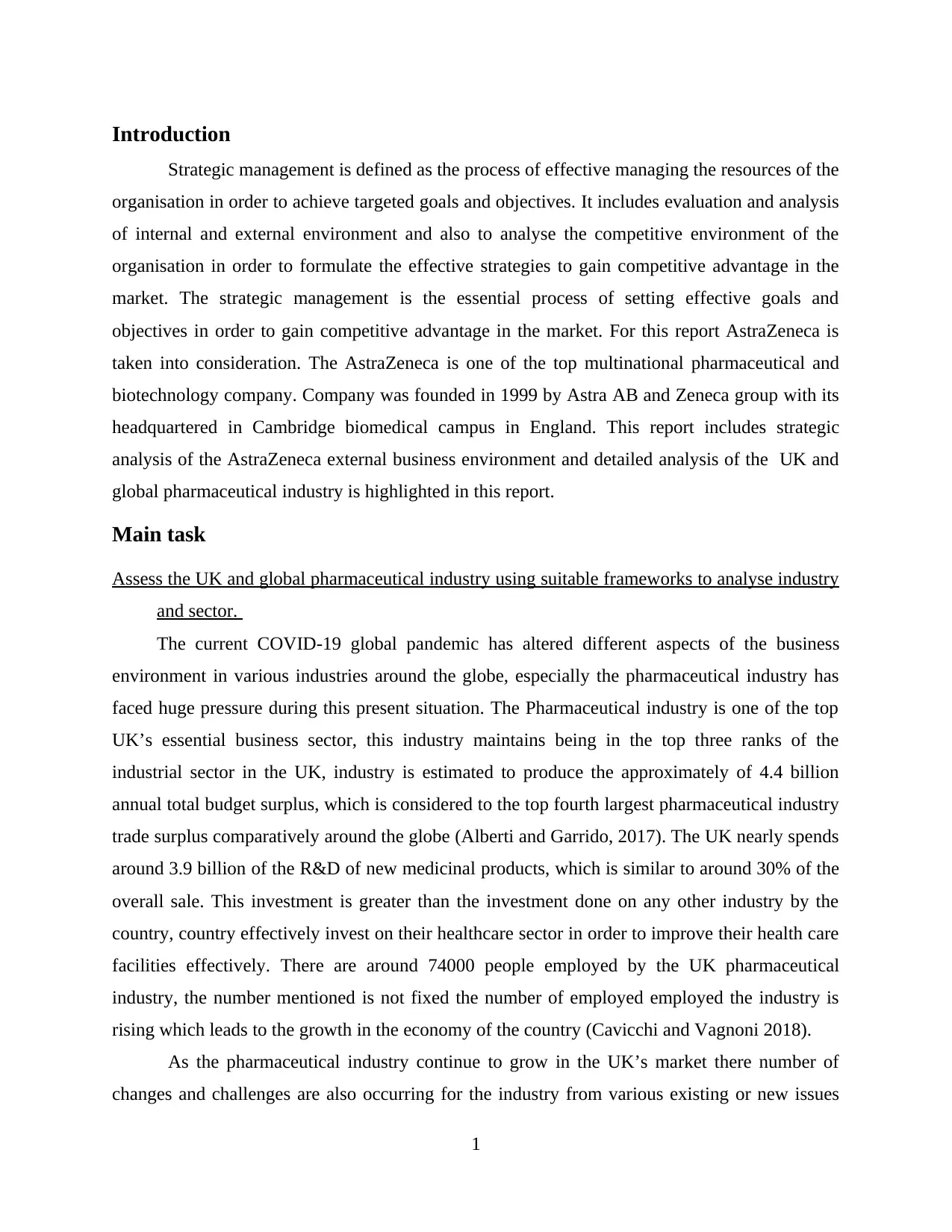
Introduction
Strategic management is defined as the process of effective managing the resources of the
organisation in order to achieve targeted goals and objectives. It includes evaluation and analysis
of internal and external environment and also to analyse the competitive environment of the
organisation in order to formulate the effective strategies to gain competitive advantage in the
market. The strategic management is the essential process of setting effective goals and
objectives in order to gain competitive advantage in the market. For this report AstraZeneca is
taken into consideration. The AstraZeneca is one of the top multinational pharmaceutical and
biotechnology company. Company was founded in 1999 by Astra AB and Zeneca group with its
headquartered in Cambridge biomedical campus in England. This report includes strategic
analysis of the AstraZeneca external business environment and detailed analysis of the UK and
global pharmaceutical industry is highlighted in this report.
Main task
Assess the UK and global pharmaceutical industry using suitable frameworks to analyse industry
and sector.
The current COVID-19 global pandemic has altered different aspects of the business
environment in various industries around the globe, especially the pharmaceutical industry has
faced huge pressure during this present situation. The Pharmaceutical industry is one of the top
UK’s essential business sector, this industry maintains being in the top three ranks of the
industrial sector in the UK, industry is estimated to produce the approximately of 4.4 billion
annual total budget surplus, which is considered to the top fourth largest pharmaceutical industry
trade surplus comparatively around the globe (Alberti and Garrido, 2017). The UK nearly spends
around 3.9 billion of the R&D of new medicinal products, which is similar to around 30% of the
overall sale. This investment is greater than the investment done on any other industry by the
country, country effectively invest on their healthcare sector in order to improve their health care
facilities effectively. There are around 74000 people employed by the UK pharmaceutical
industry, the number mentioned is not fixed the number of employed employed the industry is
rising which leads to the growth in the economy of the country (Cavicchi and Vagnoni 2018).
As the pharmaceutical industry continue to grow in the UK’s market there number of
changes and challenges are also occurring for the industry from various existing or new issues
1
Strategic management is defined as the process of effective managing the resources of the
organisation in order to achieve targeted goals and objectives. It includes evaluation and analysis
of internal and external environment and also to analyse the competitive environment of the
organisation in order to formulate the effective strategies to gain competitive advantage in the
market. The strategic management is the essential process of setting effective goals and
objectives in order to gain competitive advantage in the market. For this report AstraZeneca is
taken into consideration. The AstraZeneca is one of the top multinational pharmaceutical and
biotechnology company. Company was founded in 1999 by Astra AB and Zeneca group with its
headquartered in Cambridge biomedical campus in England. This report includes strategic
analysis of the AstraZeneca external business environment and detailed analysis of the UK and
global pharmaceutical industry is highlighted in this report.
Main task
Assess the UK and global pharmaceutical industry using suitable frameworks to analyse industry
and sector.
The current COVID-19 global pandemic has altered different aspects of the business
environment in various industries around the globe, especially the pharmaceutical industry has
faced huge pressure during this present situation. The Pharmaceutical industry is one of the top
UK’s essential business sector, this industry maintains being in the top three ranks of the
industrial sector in the UK, industry is estimated to produce the approximately of 4.4 billion
annual total budget surplus, which is considered to the top fourth largest pharmaceutical industry
trade surplus comparatively around the globe (Alberti and Garrido, 2017). The UK nearly spends
around 3.9 billion of the R&D of new medicinal products, which is similar to around 30% of the
overall sale. This investment is greater than the investment done on any other industry by the
country, country effectively invest on their healthcare sector in order to improve their health care
facilities effectively. There are around 74000 people employed by the UK pharmaceutical
industry, the number mentioned is not fixed the number of employed employed the industry is
rising which leads to the growth in the economy of the country (Cavicchi and Vagnoni 2018).
As the pharmaceutical industry continue to grow in the UK’s market there number of
changes and challenges are also occurring for the industry from various existing or new issues
1
⊘ This is a preview!⊘
Do you want full access?
Subscribe today to unlock all pages.

Trusted by 1+ million students worldwide
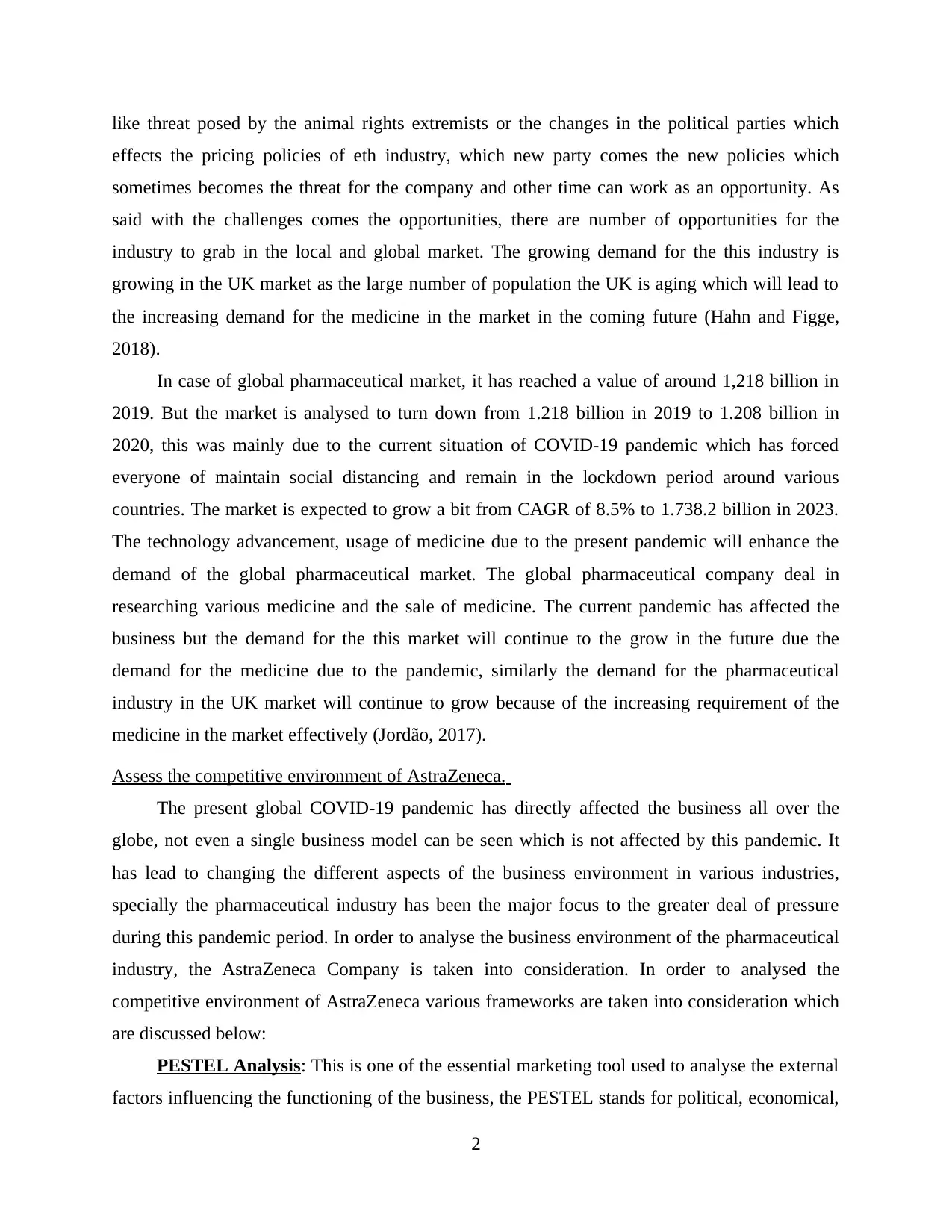
like threat posed by the animal rights extremists or the changes in the political parties which
effects the pricing policies of eth industry, which new party comes the new policies which
sometimes becomes the threat for the company and other time can work as an opportunity. As
said with the challenges comes the opportunities, there are number of opportunities for the
industry to grab in the local and global market. The growing demand for the this industry is
growing in the UK market as the large number of population the UK is aging which will lead to
the increasing demand for the medicine in the market in the coming future (Hahn and Figge,
2018).
In case of global pharmaceutical market, it has reached a value of around 1,218 billion in
2019. But the market is analysed to turn down from 1.218 billion in 2019 to 1.208 billion in
2020, this was mainly due to the current situation of COVID-19 pandemic which has forced
everyone of maintain social distancing and remain in the lockdown period around various
countries. The market is expected to grow a bit from CAGR of 8.5% to 1.738.2 billion in 2023.
The technology advancement, usage of medicine due to the present pandemic will enhance the
demand of the global pharmaceutical market. The global pharmaceutical company deal in
researching various medicine and the sale of medicine. The current pandemic has affected the
business but the demand for the this market will continue to the grow in the future due the
demand for the medicine due to the pandemic, similarly the demand for the pharmaceutical
industry in the UK market will continue to grow because of the increasing requirement of the
medicine in the market effectively (Jordão, 2017).
Assess the competitive environment of AstraZeneca.
The present global COVID-19 pandemic has directly affected the business all over the
globe, not even a single business model can be seen which is not affected by this pandemic. It
has lead to changing the different aspects of the business environment in various industries,
specially the pharmaceutical industry has been the major focus to the greater deal of pressure
during this pandemic period. In order to analyse the business environment of the pharmaceutical
industry, the AstraZeneca Company is taken into consideration. In order to analysed the
competitive environment of AstraZeneca various frameworks are taken into consideration which
are discussed below:
PESTEL Analysis: This is one of the essential marketing tool used to analyse the external
factors influencing the functioning of the business, the PESTEL stands for political, economical,
2
effects the pricing policies of eth industry, which new party comes the new policies which
sometimes becomes the threat for the company and other time can work as an opportunity. As
said with the challenges comes the opportunities, there are number of opportunities for the
industry to grab in the local and global market. The growing demand for the this industry is
growing in the UK market as the large number of population the UK is aging which will lead to
the increasing demand for the medicine in the market in the coming future (Hahn and Figge,
2018).
In case of global pharmaceutical market, it has reached a value of around 1,218 billion in
2019. But the market is analysed to turn down from 1.218 billion in 2019 to 1.208 billion in
2020, this was mainly due to the current situation of COVID-19 pandemic which has forced
everyone of maintain social distancing and remain in the lockdown period around various
countries. The market is expected to grow a bit from CAGR of 8.5% to 1.738.2 billion in 2023.
The technology advancement, usage of medicine due to the present pandemic will enhance the
demand of the global pharmaceutical market. The global pharmaceutical company deal in
researching various medicine and the sale of medicine. The current pandemic has affected the
business but the demand for the this market will continue to the grow in the future due the
demand for the medicine due to the pandemic, similarly the demand for the pharmaceutical
industry in the UK market will continue to grow because of the increasing requirement of the
medicine in the market effectively (Jordão, 2017).
Assess the competitive environment of AstraZeneca.
The present global COVID-19 pandemic has directly affected the business all over the
globe, not even a single business model can be seen which is not affected by this pandemic. It
has lead to changing the different aspects of the business environment in various industries,
specially the pharmaceutical industry has been the major focus to the greater deal of pressure
during this pandemic period. In order to analyse the business environment of the pharmaceutical
industry, the AstraZeneca Company is taken into consideration. In order to analysed the
competitive environment of AstraZeneca various frameworks are taken into consideration which
are discussed below:
PESTEL Analysis: This is one of the essential marketing tool used to analyse the external
factors influencing the functioning of the business, the PESTEL stands for political, economical,
2
Paraphrase This Document
Need a fresh take? Get an instant paraphrase of this document with our AI Paraphraser
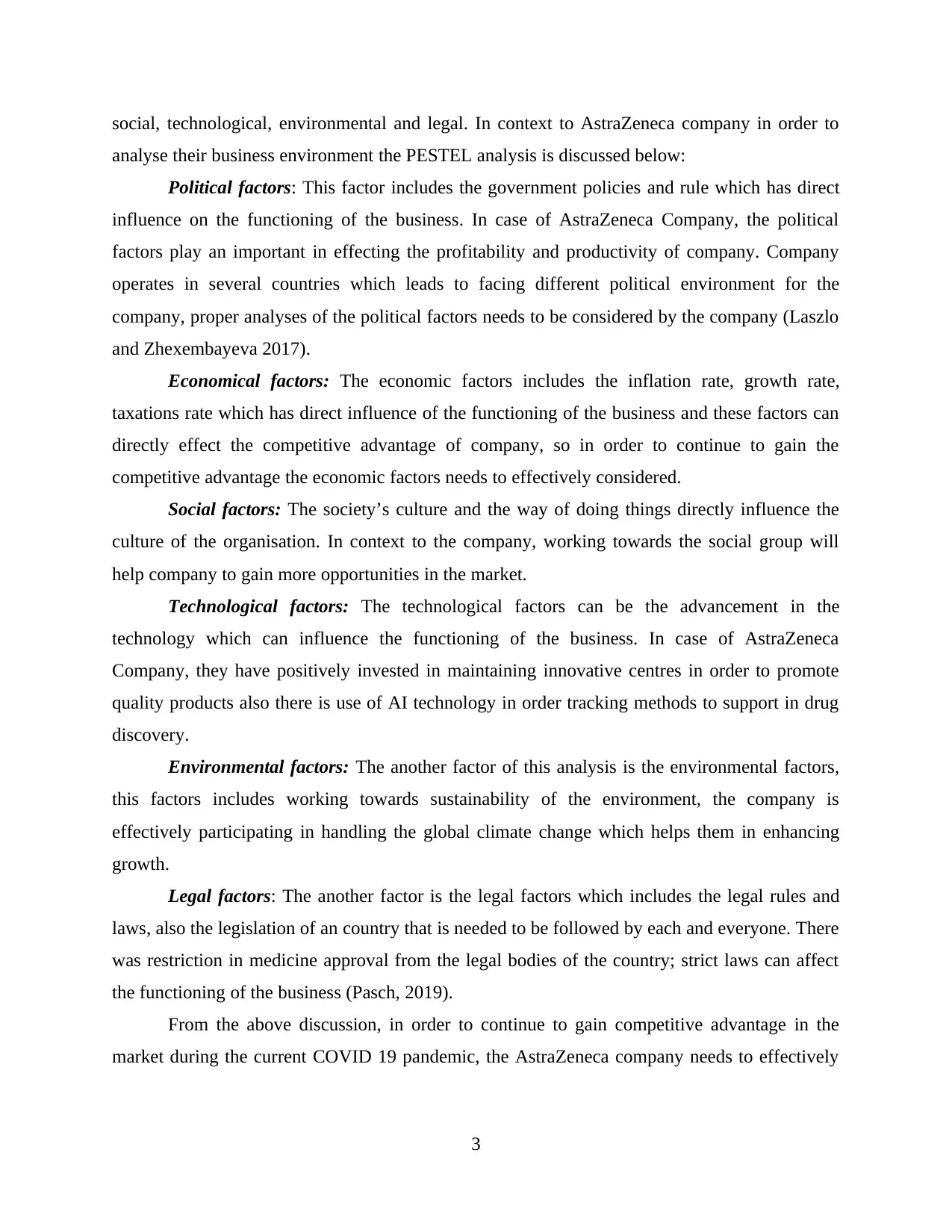
social, technological, environmental and legal. In context to AstraZeneca company in order to
analyse their business environment the PESTEL analysis is discussed below:
Political factors: This factor includes the government policies and rule which has direct
influence on the functioning of the business. In case of AstraZeneca Company, the political
factors play an important in effecting the profitability and productivity of company. Company
operates in several countries which leads to facing different political environment for the
company, proper analyses of the political factors needs to be considered by the company (Laszlo
and Zhexembayeva 2017).
Economical factors: The economic factors includes the inflation rate, growth rate,
taxations rate which has direct influence of the functioning of the business and these factors can
directly effect the competitive advantage of company, so in order to continue to gain the
competitive advantage the economic factors needs to effectively considered.
Social factors: The society’s culture and the way of doing things directly influence the
culture of the organisation. In context to the company, working towards the social group will
help company to gain more opportunities in the market.
Technological factors: The technological factors can be the advancement in the
technology which can influence the functioning of the business. In case of AstraZeneca
Company, they have positively invested in maintaining innovative centres in order to promote
quality products also there is use of AI technology in order tracking methods to support in drug
discovery.
Environmental factors: The another factor of this analysis is the environmental factors,
this factors includes working towards sustainability of the environment, the company is
effectively participating in handling the global climate change which helps them in enhancing
growth.
Legal factors: The another factor is the legal factors which includes the legal rules and
laws, also the legislation of an country that is needed to be followed by each and everyone. There
was restriction in medicine approval from the legal bodies of the country; strict laws can affect
the functioning of the business (Pasch, 2019).
From the above discussion, in order to continue to gain competitive advantage in the
market during the current COVID 19 pandemic, the AstraZeneca company needs to effectively
3
analyse their business environment the PESTEL analysis is discussed below:
Political factors: This factor includes the government policies and rule which has direct
influence on the functioning of the business. In case of AstraZeneca Company, the political
factors play an important in effecting the profitability and productivity of company. Company
operates in several countries which leads to facing different political environment for the
company, proper analyses of the political factors needs to be considered by the company (Laszlo
and Zhexembayeva 2017).
Economical factors: The economic factors includes the inflation rate, growth rate,
taxations rate which has direct influence of the functioning of the business and these factors can
directly effect the competitive advantage of company, so in order to continue to gain the
competitive advantage the economic factors needs to effectively considered.
Social factors: The society’s culture and the way of doing things directly influence the
culture of the organisation. In context to the company, working towards the social group will
help company to gain more opportunities in the market.
Technological factors: The technological factors can be the advancement in the
technology which can influence the functioning of the business. In case of AstraZeneca
Company, they have positively invested in maintaining innovative centres in order to promote
quality products also there is use of AI technology in order tracking methods to support in drug
discovery.
Environmental factors: The another factor of this analysis is the environmental factors,
this factors includes working towards sustainability of the environment, the company is
effectively participating in handling the global climate change which helps them in enhancing
growth.
Legal factors: The another factor is the legal factors which includes the legal rules and
laws, also the legislation of an country that is needed to be followed by each and everyone. There
was restriction in medicine approval from the legal bodies of the country; strict laws can affect
the functioning of the business (Pasch, 2019).
From the above discussion, in order to continue to gain competitive advantage in the
market during the current COVID 19 pandemic, the AstraZeneca company needs to effectively
3
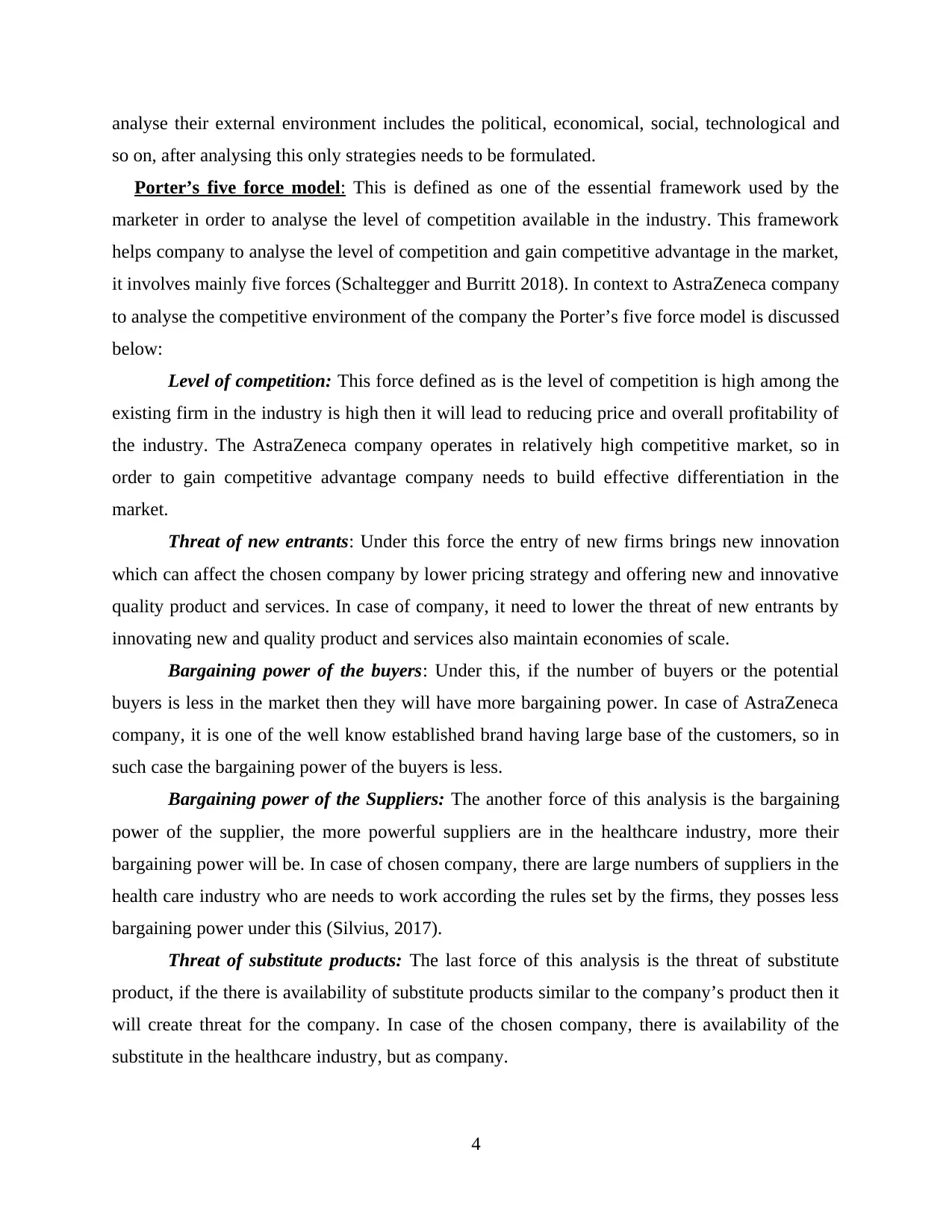
analyse their external environment includes the political, economical, social, technological and
so on, after analysing this only strategies needs to be formulated.
Porter’s five force model: This is defined as one of the essential framework used by the
marketer in order to analyse the level of competition available in the industry. This framework
helps company to analyse the level of competition and gain competitive advantage in the market,
it involves mainly five forces (Schaltegger and Burritt 2018). In context to AstraZeneca company
to analyse the competitive environment of the company the Porter’s five force model is discussed
below:
Level of competition: This force defined as is the level of competition is high among the
existing firm in the industry is high then it will lead to reducing price and overall profitability of
the industry. The AstraZeneca company operates in relatively high competitive market, so in
order to gain competitive advantage company needs to build effective differentiation in the
market.
Threat of new entrants: Under this force the entry of new firms brings new innovation
which can affect the chosen company by lower pricing strategy and offering new and innovative
quality product and services. In case of company, it need to lower the threat of new entrants by
innovating new and quality product and services also maintain economies of scale.
Bargaining power of the buyers: Under this, if the number of buyers or the potential
buyers is less in the market then they will have more bargaining power. In case of AstraZeneca
company, it is one of the well know established brand having large base of the customers, so in
such case the bargaining power of the buyers is less.
Bargaining power of the Suppliers: The another force of this analysis is the bargaining
power of the supplier, the more powerful suppliers are in the healthcare industry, more their
bargaining power will be. In case of chosen company, there are large numbers of suppliers in the
health care industry who are needs to work according the rules set by the firms, they posses less
bargaining power under this (Silvius, 2017).
Threat of substitute products: The last force of this analysis is the threat of substitute
product, if the there is availability of substitute products similar to the company’s product then it
will create threat for the company. In case of the chosen company, there is availability of the
substitute in the healthcare industry, but as company.
4
so on, after analysing this only strategies needs to be formulated.
Porter’s five force model: This is defined as one of the essential framework used by the
marketer in order to analyse the level of competition available in the industry. This framework
helps company to analyse the level of competition and gain competitive advantage in the market,
it involves mainly five forces (Schaltegger and Burritt 2018). In context to AstraZeneca company
to analyse the competitive environment of the company the Porter’s five force model is discussed
below:
Level of competition: This force defined as is the level of competition is high among the
existing firm in the industry is high then it will lead to reducing price and overall profitability of
the industry. The AstraZeneca company operates in relatively high competitive market, so in
order to gain competitive advantage company needs to build effective differentiation in the
market.
Threat of new entrants: Under this force the entry of new firms brings new innovation
which can affect the chosen company by lower pricing strategy and offering new and innovative
quality product and services. In case of company, it need to lower the threat of new entrants by
innovating new and quality product and services also maintain economies of scale.
Bargaining power of the buyers: Under this, if the number of buyers or the potential
buyers is less in the market then they will have more bargaining power. In case of AstraZeneca
company, it is one of the well know established brand having large base of the customers, so in
such case the bargaining power of the buyers is less.
Bargaining power of the Suppliers: The another force of this analysis is the bargaining
power of the supplier, the more powerful suppliers are in the healthcare industry, more their
bargaining power will be. In case of chosen company, there are large numbers of suppliers in the
health care industry who are needs to work according the rules set by the firms, they posses less
bargaining power under this (Silvius, 2017).
Threat of substitute products: The last force of this analysis is the threat of substitute
product, if the there is availability of substitute products similar to the company’s product then it
will create threat for the company. In case of the chosen company, there is availability of the
substitute in the healthcare industry, but as company.
4
⊘ This is a preview!⊘
Do you want full access?
Subscribe today to unlock all pages.

Trusted by 1+ million students worldwide
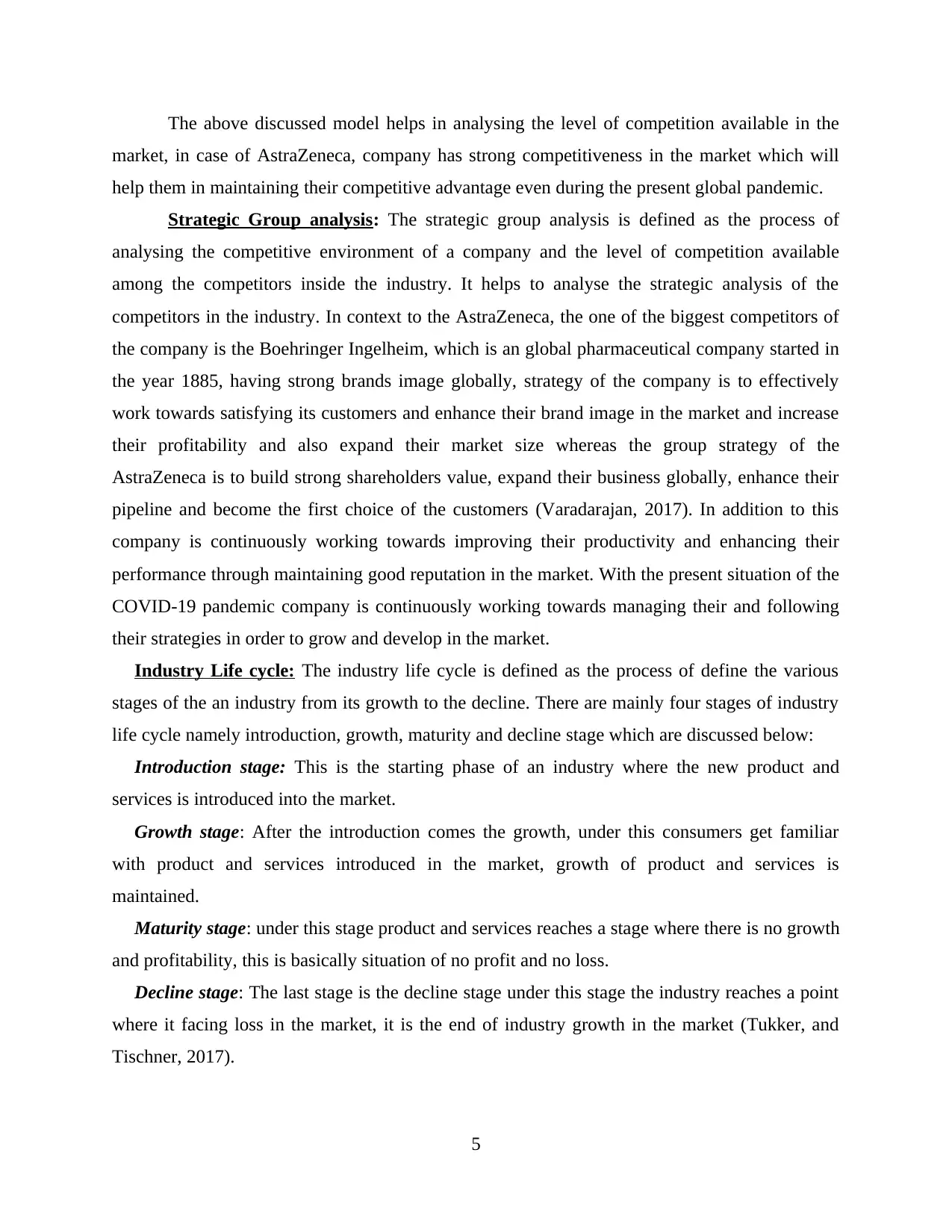
The above discussed model helps in analysing the level of competition available in the
market, in case of AstraZeneca, company has strong competitiveness in the market which will
help them in maintaining their competitive advantage even during the present global pandemic.
Strategic Group analysis: The strategic group analysis is defined as the process of
analysing the competitive environment of a company and the level of competition available
among the competitors inside the industry. It helps to analyse the strategic analysis of the
competitors in the industry. In context to the AstraZeneca, the one of the biggest competitors of
the company is the Boehringer Ingelheim, which is an global pharmaceutical company started in
the year 1885, having strong brands image globally, strategy of the company is to effectively
work towards satisfying its customers and enhance their brand image in the market and increase
their profitability and also expand their market size whereas the group strategy of the
AstraZeneca is to build strong shareholders value, expand their business globally, enhance their
pipeline and become the first choice of the customers (Varadarajan, 2017). In addition to this
company is continuously working towards improving their productivity and enhancing their
performance through maintaining good reputation in the market. With the present situation of the
COVID-19 pandemic company is continuously working towards managing their and following
their strategies in order to grow and develop in the market.
Industry Life cycle: The industry life cycle is defined as the process of define the various
stages of the an industry from its growth to the decline. There are mainly four stages of industry
life cycle namely introduction, growth, maturity and decline stage which are discussed below:
Introduction stage: This is the starting phase of an industry where the new product and
services is introduced into the market.
Growth stage: After the introduction comes the growth, under this consumers get familiar
with product and services introduced in the market, growth of product and services is
maintained.
Maturity stage: under this stage product and services reaches a stage where there is no growth
and profitability, this is basically situation of no profit and no loss.
Decline stage: The last stage is the decline stage under this stage the industry reaches a point
where it facing loss in the market, it is the end of industry growth in the market (Tukker, and
Tischner, 2017).
5
market, in case of AstraZeneca, company has strong competitiveness in the market which will
help them in maintaining their competitive advantage even during the present global pandemic.
Strategic Group analysis: The strategic group analysis is defined as the process of
analysing the competitive environment of a company and the level of competition available
among the competitors inside the industry. It helps to analyse the strategic analysis of the
competitors in the industry. In context to the AstraZeneca, the one of the biggest competitors of
the company is the Boehringer Ingelheim, which is an global pharmaceutical company started in
the year 1885, having strong brands image globally, strategy of the company is to effectively
work towards satisfying its customers and enhance their brand image in the market and increase
their profitability and also expand their market size whereas the group strategy of the
AstraZeneca is to build strong shareholders value, expand their business globally, enhance their
pipeline and become the first choice of the customers (Varadarajan, 2017). In addition to this
company is continuously working towards improving their productivity and enhancing their
performance through maintaining good reputation in the market. With the present situation of the
COVID-19 pandemic company is continuously working towards managing their and following
their strategies in order to grow and develop in the market.
Industry Life cycle: The industry life cycle is defined as the process of define the various
stages of the an industry from its growth to the decline. There are mainly four stages of industry
life cycle namely introduction, growth, maturity and decline stage which are discussed below:
Introduction stage: This is the starting phase of an industry where the new product and
services is introduced into the market.
Growth stage: After the introduction comes the growth, under this consumers get familiar
with product and services introduced in the market, growth of product and services is
maintained.
Maturity stage: under this stage product and services reaches a stage where there is no growth
and profitability, this is basically situation of no profit and no loss.
Decline stage: The last stage is the decline stage under this stage the industry reaches a point
where it facing loss in the market, it is the end of industry growth in the market (Tukker, and
Tischner, 2017).
5
Paraphrase This Document
Need a fresh take? Get an instant paraphrase of this document with our AI Paraphraser
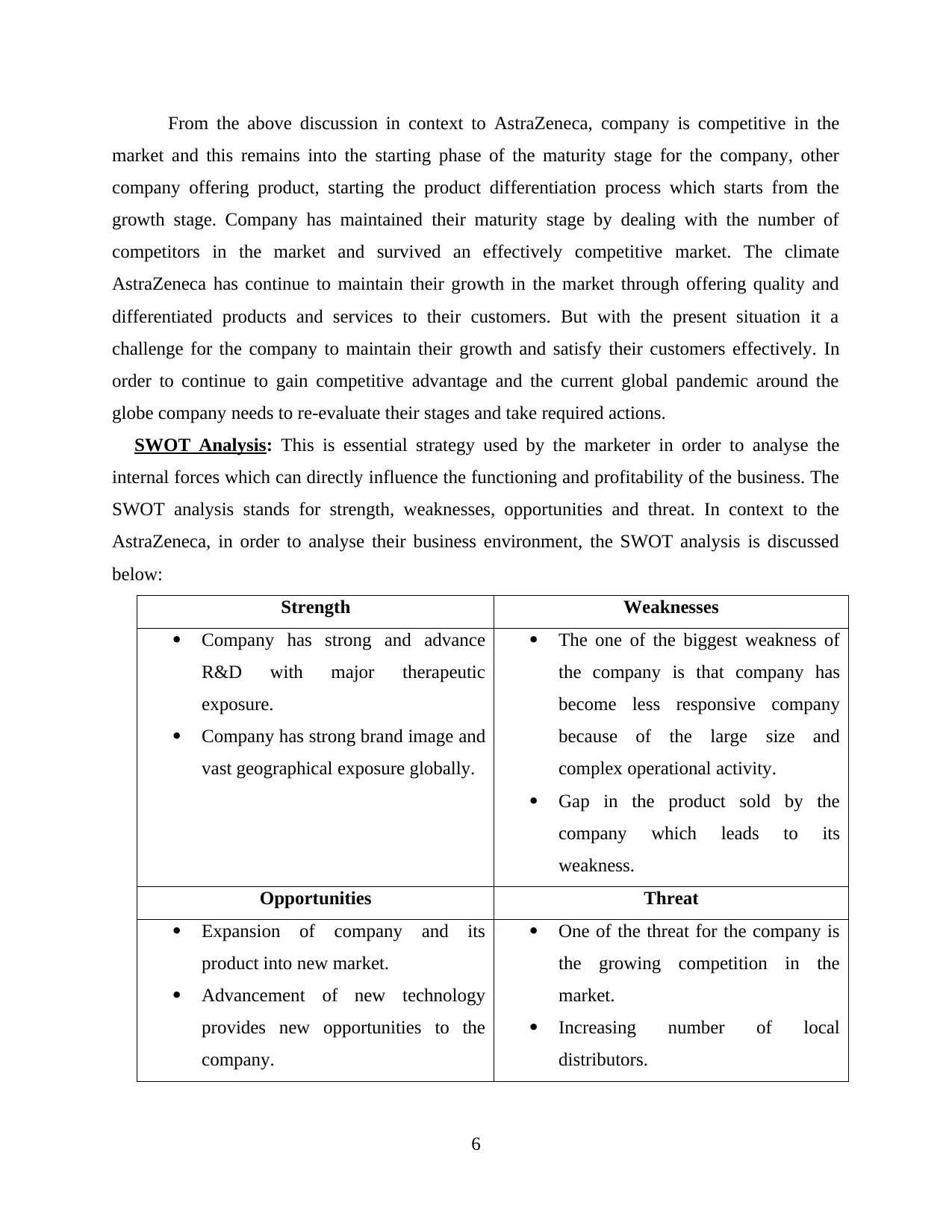
From the above discussion in context to AstraZeneca, company is competitive in the
market and this remains into the starting phase of the maturity stage for the company, other
company offering product, starting the product differentiation process which starts from the
growth stage. Company has maintained their maturity stage by dealing with the number of
competitors in the market and survived an effectively competitive market. The climate
AstraZeneca has continue to maintain their growth in the market through offering quality and
differentiated products and services to their customers. But with the present situation it a
challenge for the company to maintain their growth and satisfy their customers effectively. In
order to continue to gain competitive advantage and the current global pandemic around the
globe company needs to re-evaluate their stages and take required actions.
SWOT Analysis: This is essential strategy used by the marketer in order to analyse the
internal forces which can directly influence the functioning and profitability of the business. The
SWOT analysis stands for strength, weaknesses, opportunities and threat. In context to the
AstraZeneca, in order to analyse their business environment, the SWOT analysis is discussed
below:
Strength Weaknesses
Company has strong and advance
R&D with major therapeutic
exposure.
Company has strong brand image and
vast geographical exposure globally.
The one of the biggest weakness of
the company is that company has
become less responsive company
because of the large size and
complex operational activity.
Gap in the product sold by the
company which leads to its
weakness.
Opportunities Threat
Expansion of company and its
product into new market.
Advancement of new technology
provides new opportunities to the
company.
One of the threat for the company is
the growing competition in the
market.
Increasing number of local
distributors.
6
market and this remains into the starting phase of the maturity stage for the company, other
company offering product, starting the product differentiation process which starts from the
growth stage. Company has maintained their maturity stage by dealing with the number of
competitors in the market and survived an effectively competitive market. The climate
AstraZeneca has continue to maintain their growth in the market through offering quality and
differentiated products and services to their customers. But with the present situation it a
challenge for the company to maintain their growth and satisfy their customers effectively. In
order to continue to gain competitive advantage and the current global pandemic around the
globe company needs to re-evaluate their stages and take required actions.
SWOT Analysis: This is essential strategy used by the marketer in order to analyse the
internal forces which can directly influence the functioning and profitability of the business. The
SWOT analysis stands for strength, weaknesses, opportunities and threat. In context to the
AstraZeneca, in order to analyse their business environment, the SWOT analysis is discussed
below:
Strength Weaknesses
Company has strong and advance
R&D with major therapeutic
exposure.
Company has strong brand image and
vast geographical exposure globally.
The one of the biggest weakness of
the company is that company has
become less responsive company
because of the large size and
complex operational activity.
Gap in the product sold by the
company which leads to its
weakness.
Opportunities Threat
Expansion of company and its
product into new market.
Advancement of new technology
provides new opportunities to the
company.
One of the threat for the company is
the growing competition in the
market.
Increasing number of local
distributors.
6
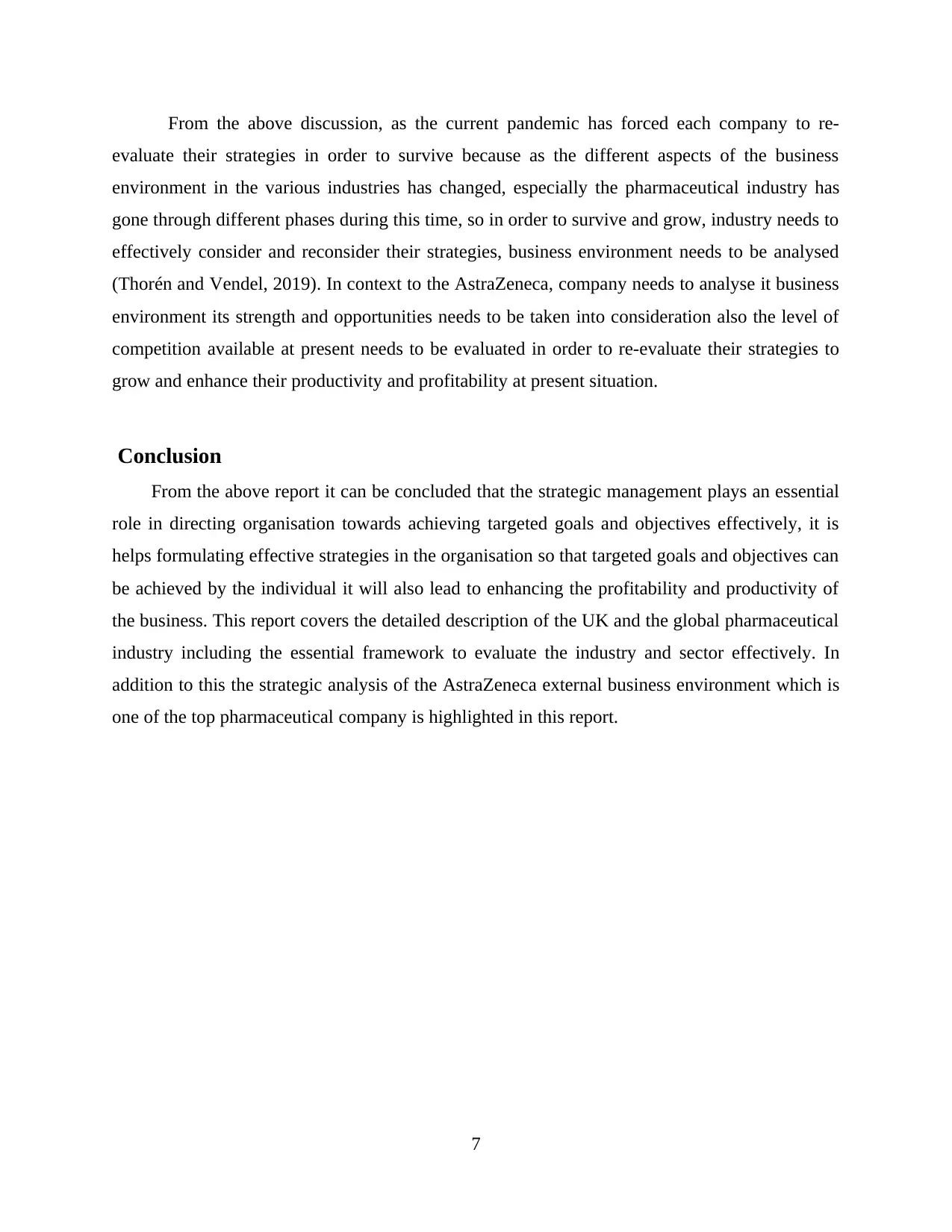
From the above discussion, as the current pandemic has forced each company to re-
evaluate their strategies in order to survive because as the different aspects of the business
environment in the various industries has changed, especially the pharmaceutical industry has
gone through different phases during this time, so in order to survive and grow, industry needs to
effectively consider and reconsider their strategies, business environment needs to be analysed
(Thorén and Vendel, 2019). In context to the AstraZeneca, company needs to analyse it business
environment its strength and opportunities needs to be taken into consideration also the level of
competition available at present needs to be evaluated in order to re-evaluate their strategies to
grow and enhance their productivity and profitability at present situation.
Conclusion
From the above report it can be concluded that the strategic management plays an essential
role in directing organisation towards achieving targeted goals and objectives effectively, it is
helps formulating effective strategies in the organisation so that targeted goals and objectives can
be achieved by the individual it will also lead to enhancing the profitability and productivity of
the business. This report covers the detailed description of the UK and the global pharmaceutical
industry including the essential framework to evaluate the industry and sector effectively. In
addition to this the strategic analysis of the AstraZeneca external business environment which is
one of the top pharmaceutical company is highlighted in this report.
7
evaluate their strategies in order to survive because as the different aspects of the business
environment in the various industries has changed, especially the pharmaceutical industry has
gone through different phases during this time, so in order to survive and grow, industry needs to
effectively consider and reconsider their strategies, business environment needs to be analysed
(Thorén and Vendel, 2019). In context to the AstraZeneca, company needs to analyse it business
environment its strength and opportunities needs to be taken into consideration also the level of
competition available at present needs to be evaluated in order to re-evaluate their strategies to
grow and enhance their productivity and profitability at present situation.
Conclusion
From the above report it can be concluded that the strategic management plays an essential
role in directing organisation towards achieving targeted goals and objectives effectively, it is
helps formulating effective strategies in the organisation so that targeted goals and objectives can
be achieved by the individual it will also lead to enhancing the profitability and productivity of
the business. This report covers the detailed description of the UK and the global pharmaceutical
industry including the essential framework to evaluate the industry and sector effectively. In
addition to this the strategic analysis of the AstraZeneca external business environment which is
one of the top pharmaceutical company is highlighted in this report.
7
⊘ This is a preview!⊘
Do you want full access?
Subscribe today to unlock all pages.

Trusted by 1+ million students worldwide
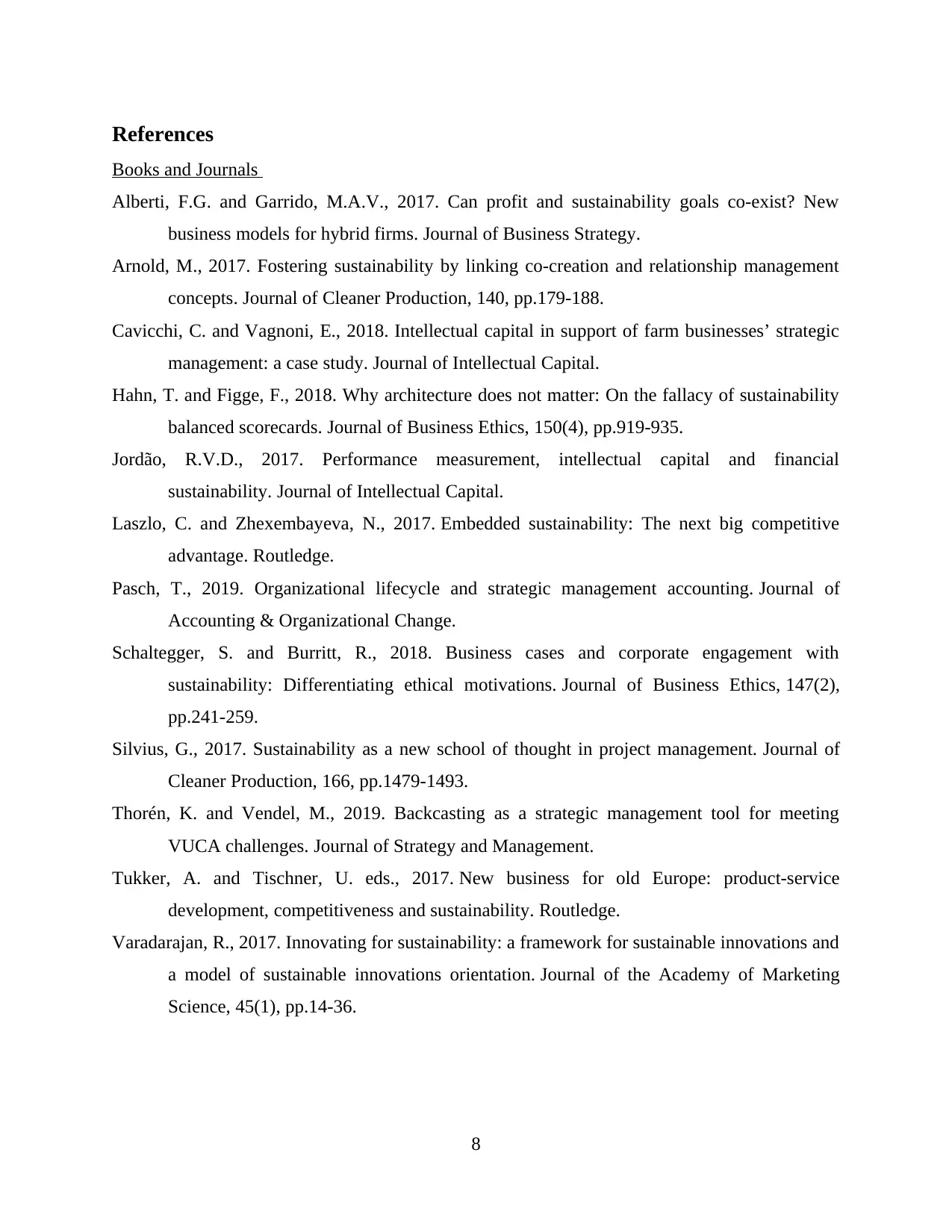
References
Books and Journals
Alberti, F.G. and Garrido, M.A.V., 2017. Can profit and sustainability goals co-exist? New
business models for hybrid firms. Journal of Business Strategy.
Arnold, M., 2017. Fostering sustainability by linking co-creation and relationship management
concepts. Journal of Cleaner Production, 140, pp.179-188.
Cavicchi, C. and Vagnoni, E., 2018. Intellectual capital in support of farm businesses’ strategic
management: a case study. Journal of Intellectual Capital.
Hahn, T. and Figge, F., 2018. Why architecture does not matter: On the fallacy of sustainability
balanced scorecards. Journal of Business Ethics, 150(4), pp.919-935.
Jordão, R.V.D., 2017. Performance measurement, intellectual capital and financial
sustainability. Journal of Intellectual Capital.
Laszlo, C. and Zhexembayeva, N., 2017. Embedded sustainability: The next big competitive
advantage. Routledge.
Pasch, T., 2019. Organizational lifecycle and strategic management accounting. Journal of
Accounting & Organizational Change.
Schaltegger, S. and Burritt, R., 2018. Business cases and corporate engagement with
sustainability: Differentiating ethical motivations. Journal of Business Ethics, 147(2),
pp.241-259.
Silvius, G., 2017. Sustainability as a new school of thought in project management. Journal of
Cleaner Production, 166, pp.1479-1493.
Thorén, K. and Vendel, M., 2019. Backcasting as a strategic management tool for meeting
VUCA challenges. Journal of Strategy and Management.
Tukker, A. and Tischner, U. eds., 2017. New business for old Europe: product-service
development, competitiveness and sustainability. Routledge.
Varadarajan, R., 2017. Innovating for sustainability: a framework for sustainable innovations and
a model of sustainable innovations orientation. Journal of the Academy of Marketing
Science, 45(1), pp.14-36.
8
Books and Journals
Alberti, F.G. and Garrido, M.A.V., 2017. Can profit and sustainability goals co-exist? New
business models for hybrid firms. Journal of Business Strategy.
Arnold, M., 2017. Fostering sustainability by linking co-creation and relationship management
concepts. Journal of Cleaner Production, 140, pp.179-188.
Cavicchi, C. and Vagnoni, E., 2018. Intellectual capital in support of farm businesses’ strategic
management: a case study. Journal of Intellectual Capital.
Hahn, T. and Figge, F., 2018. Why architecture does not matter: On the fallacy of sustainability
balanced scorecards. Journal of Business Ethics, 150(4), pp.919-935.
Jordão, R.V.D., 2017. Performance measurement, intellectual capital and financial
sustainability. Journal of Intellectual Capital.
Laszlo, C. and Zhexembayeva, N., 2017. Embedded sustainability: The next big competitive
advantage. Routledge.
Pasch, T., 2019. Organizational lifecycle and strategic management accounting. Journal of
Accounting & Organizational Change.
Schaltegger, S. and Burritt, R., 2018. Business cases and corporate engagement with
sustainability: Differentiating ethical motivations. Journal of Business Ethics, 147(2),
pp.241-259.
Silvius, G., 2017. Sustainability as a new school of thought in project management. Journal of
Cleaner Production, 166, pp.1479-1493.
Thorén, K. and Vendel, M., 2019. Backcasting as a strategic management tool for meeting
VUCA challenges. Journal of Strategy and Management.
Tukker, A. and Tischner, U. eds., 2017. New business for old Europe: product-service
development, competitiveness and sustainability. Routledge.
Varadarajan, R., 2017. Innovating for sustainability: a framework for sustainable innovations and
a model of sustainable innovations orientation. Journal of the Academy of Marketing
Science, 45(1), pp.14-36.
8
1 out of 10
Related Documents
Your All-in-One AI-Powered Toolkit for Academic Success.
+13062052269
info@desklib.com
Available 24*7 on WhatsApp / Email
![[object Object]](/_next/static/media/star-bottom.7253800d.svg)
Unlock your academic potential
Copyright © 2020–2025 A2Z Services. All Rights Reserved. Developed and managed by ZUCOL.




